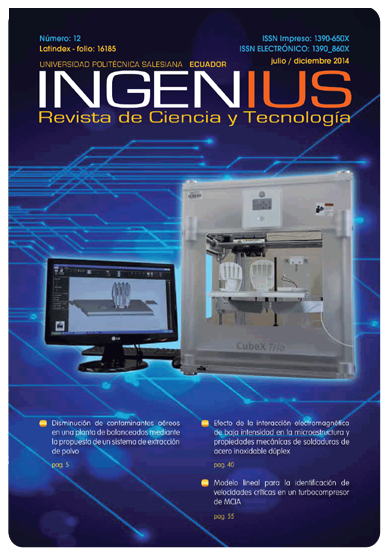Risk of Tsunami in Ecuador
Main Article Content
Abstract
Article Details
The Universidad Politécnica Salesiana of Ecuador preserves the copyrights of the published works and will favor the reuse of the works. The works are published in the electronic edition of the journal under a Creative Commons Attribution/Noncommercial-No Derivative Works 4.0 Ecuador license: they can be copied, used, disseminated, transmitted and publicly displayed.
The undersigned author partially transfers the copyrights of this work to the Universidad Politécnica Salesiana of Ecuador for printed editions.
It is also stated that they have respected the ethical principles of research and are free from any conflict of interest. The author(s) certify that this work has not been published, nor is it under consideration for publication in any other journal or editorial work.
The author (s) are responsible for their content and have contributed to the conception, design and completion of the work, analysis and interpretation of data, and to have participated in the writing of the text and its revisions, as well as in the approval of the version which is finally referred to as an attachment.
References
A. Giesecke, A. Gómez, I. Leschiutta, E. Migliorini, and L. Rodríguez, “The ceresis earthquake catalogue and database of the andean region: background, characteristics and examples of use.” Annals of Geophysics, vol. 47(2/3), pp. 421–435, 2004.
R. Blanco-Chao, K. Pedoja, C. Witt, J. Martinod, L. Husson, V. Regard, L. Audin, M. Nexer, B. Delcaillau, M. Saillard, D. Melnick, J. F. Dumont, E. Santana, E. Navarrete, C. Martillo, M. Pappalardo,
L. Ayala, J. F. Araya, A. Feal-Pérez, D. Correa, and I. Arozarena-Llopis, “The rock coast of south and central america.” Geological Society, London, Memoirs, vol. 40, pp. 155–191, 2014.
INOCAR, “Derrotero de las costas ecuatorianas,” Sexta edición, 2014. [Online]. Available: http://www.inocar.mil.ec/web/index.php/ derrotero-costas-ecuatorianas, 2014.
M. Cruz, M. Acosta, and M. Vásquez, “Riesgos por tsunami en la costa ecuatoriana.” nacional del Ecuador del Instituto Panamericano de Geografia e Historia, Organizacion de Estados Americanos, OEA. Publicaciones de geofísica., 2005. [Online]. Available: http://www. ipgh.gob.ec/index.php/geofisica/publicaciones/ 67-riesgos-por-tsunami-en-la-costa-ecuatoriana
J. Espinoza, “Terremotos tsunamigénicos en el ecuador,” Acta Oceanográfica del Pacífico. IN-
OCAR, vol. 7(1), pp. 21–28, 1992.
M. Contreras-López, “Cronología de tsunamis en ecuador desde 1586 a 2012,” Revista "La Técnica" Universidad Técnica de Manabí, no. 11, pp. 50–59, 2013.
RTU. (2011) Alerta de tsunami en ecuador. Canal de Noticias. (Junio de 2013). [Online]. Available: http://www.rtu.com.ec/nacionales/ 15555-emergencia-de-tsunami-en-ecuador
A. Acosta, “Breve historia económica del ecuador.” Segunda edición actualizada. Corporación Editora Nacional, Quito., p. 406, 2006.
M. Contreras-López, “Tsunamis en ecuador: Cronologíaa desde catálogos y bases de datos mundiales,” Documento Técnico N. 01/2014, Facultad de Ingeniería, Universidad de Playa Ancha, Valparaíso, p. 25, 2014.
P. Winckler, M. Reyes, and M. Contreras, “Recomendaciones de dise no de obras marítimas y terrestres sometidas a cargas de tsunamis.” Anales del Instituto de Ingenieros de Chile, 123(1), pp. 19–39, 2011.
N. Shuto and K. Fujima, “A short history of tsunami research and countermeasures in japan.” Proc. Japan. Acad., Ser. B 85, no. 8, pp. 267–275, 2009.
J. Raskin, Y. Wang, M. Boyer, T. Fiez, J. Moncada, K. Yu, and H. Yeh, “An evacuation building project for cascadia earthquakes and tsunamis.” Obras y Proyectos, no. 9, pp. 11–22, 2011.
M. Lagos, “Tsunamis de origen cercano a las costas de chile.” Revista de Geografía Norte Grande, 27, pp. 93–102, 2000.
P. Arreaga, “Estudio de los tsunamis en la costa sur del ecuador (golfo de guayaquil).” Pesquisa Naval, no. 11, pp. 79–94, 1998.
P. Arreaga and M. Ortiz, “Análisis de riesgo de inundación por tsunamis en el golfo de guayaquil.” Acta Oceanográfica del Pacífico, vol. 11, pp. 23–29, 2002.
W. Rentería, “Elaboración de mapas digitales de inundación por tsunamis para machala y salinas basados en el tsunami histórico de 1953.” Acta Oceanográfica del Pacífico,, pp. 207–216, 2007.
J. Espinoza, “Impactos de fenómenos oceánicos.” Centro Regional de Información sobre Desastres (CRID), p. 12, 2006. [Online]. Available: http://
cidbimena.desastres.hn/docum/crid/Enero2006/ CD-1/pdf/spa/doc9219/doc9219-contenido.pdf
A. Marín, S. Gelcich, G. Araya, G. Olea, M. Espíndola, and J. C. Castilla, “The 2010 tsunami in chile: Devastation and survival of coastal smallscale fishing communities.” Marine Policy., vol. 34, pp. 1381–1384, 2010.

